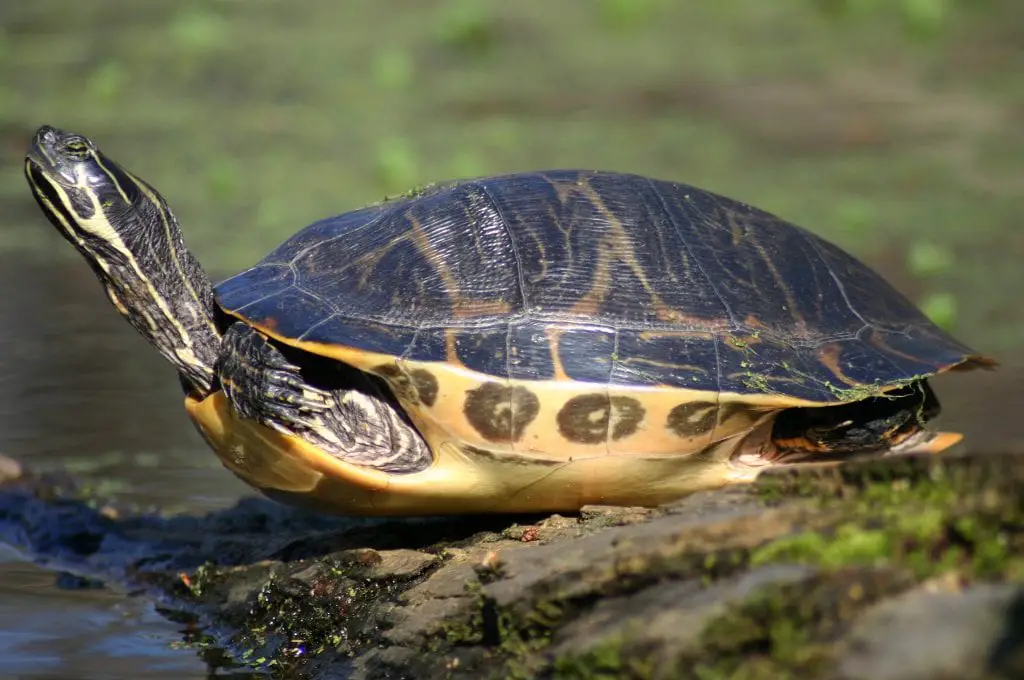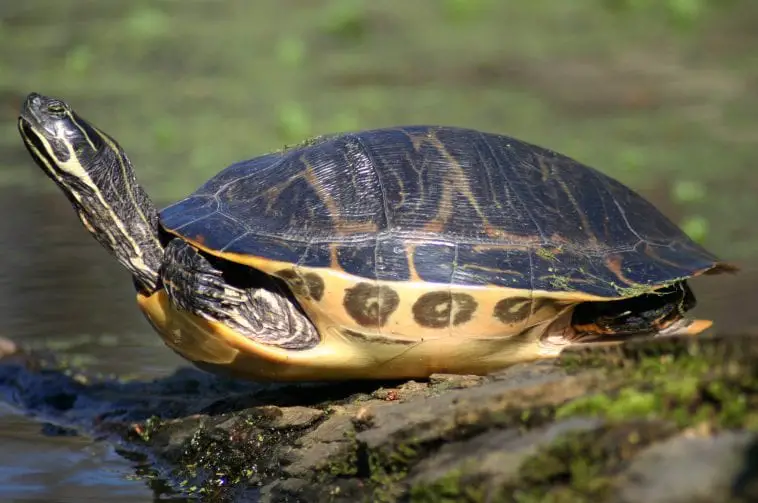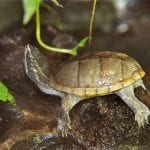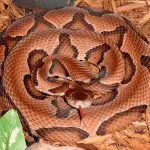Scientific Facts
| Common Name: | Cooter Turtle |
| Scientific Name: | Pseudemys concinna |
| Life Span: | 40 years (in captivity) |
| Size: | From 27 mm (hatchlings) to 44 centimeters (adults) |
| Habitat: | Lakes, rivers, springs, swamps, and ponds |
| Country of Origin: | North America |
Physical Description

Cooter turtles range from 27 to 39 mm long upon hatching. At this stage, their weight is typically between 5.2 to 14 grams. Hatchlings are bright green with light-colored markings all over. As they grow old, these markings get darker and darker. Fully grown cooter turtles have longer shells – the biggest one can be 43.7 cm long.
In general, adult cooter turtles have oval-shaped, elongated, and flattened shells with dark and light brown markings. Every shell is quite different, but it often includes patterns in various colors, including yellow, green, black, and brown.
Sexual dimorphism is common in cooter turtles. The females are usually bigger with their carapace reaching 287 mm in length while it’s only 223 mm for males. Moreover, the shells of males are flatter compared to the shells of females. They also have elongated foreclaws while females don’t.
The strength of various water currents is also a major factor that affects the physical features of cooter turtles. Their shells form lower or higher drag morphologies associated with the strength of water currents in a specific habitat. Those cooter turtles that acclimatize to develop a flatter shell to prevent it from dislodging from their physique generally have weaker shells compared to other turtles with a dome-shaped shell.
Geographic Range
Cooter turtles are more common in North America. These turtles often exist in the central and eastern portions of the US. They exist in northern Ohio up to northern Florida in the south.
The distribution of cooter turtles is from eastern Virginia to eastern and westward Texas. Disjunct populations of the cooter turtles can be seen in the New River in West Virginia, eastern Kentucky, and the Tennessee River in Tennessee.
Habitat
Cooter turtles are primarily present in the lakes, rivers, and other bodies of freshwater. In some instances, these turtles stay in the springs, swamps, ponds, and even seawater tributaries. The habitat of cooter turtles is overloaded with different kinds of marine flora and aquatic plants.
Though they are somewhat shallow (measuring 0 to 2 meters deep), this habitat is often inaccessible to people, which is one way of protecting, especially the hatchlings from predation attempts and anthropogenic disturbances.
Cooter turtles love nesting and basking, which frequently happen in telluric environments that are often 30 meters away from the bodies of water. They often spend their time in the water.
Behavior
Cooter turtles love basking on logs and rocks that have been exposed to sunlight. They are often found doing this together with some other marine basking turtles like painteds and sliders. At times, they enjoy basking in a piled-up position. They quickly run away to the water when disturbed. Cooter turtles are diurnal as they wake up as the sun rises to bask and feed themselves.
These animals can move with amazing speed back to the water and on the land. They often go from one body of freshwater to the other. Many of them develop big home ranges, and they seldom leave these places. Sometimes, they prefer spending a lifetime in these home ranges.
They sleep in the water at the back of the plants living down there. While those cooter turtles live in warm regions stay active during winter, their counterparts living in colder areas become dormant during the season in 1 to 2 months.
Hibernating cooter turtles don’t breathe throughout this period when their metabolism slows down. Despite that, their bodies can use the oxygen available in the water, taking it in using their cloaca. Cooter turtles keep themselves well hidden when hibernating as they become more vulnerable to predators during this period.
Life Span
In captivity, cooter turtles can live for 40 years or even longer.
Food
While cooter turtles are herbivores, they can also eat animals – alive or dead. Their diet seems to depend on what type of food is available. While these turtles seem to refuse when offered with meat, their predatory behavior becomes more noticeable in this scenario.
Though these turtles can’t swallow out of the water, they leave for the meantime to catch a worm or bug and go back to the water so that they can eat and swallow their victims.
Furthermore, cooter turtles also actively chase, slay, and swallow small fish. In some cases, they were seen eating carrion, which they found near the river’s border. These turtles have tooth-like tips in their upper jaw, which they might be using to eat leaves or fibrous vegetables.
Their diet includes a range of aquatic plants and a few terrestrial plants that are growing close to the river’s border.
Captive-bred and raised cooter turtles will also eat plants of any type and some “meats.” In taking care of these turtles, you should keep a stable supply of calcium in a different form. A cuttlebone is a good example. Doing this will help these animals in self-regulating their calcium intake.
Reproduction
Like other basking turtles, the male cooter turtles and smaller than females. They have long and straight claws, which aid them in doing the “mating dance.” After detecting the pheromone signal as it sniffs the female’s tail, the male turtle will court the female by swimming on top of her. As he does, his long nails will vibrate and stroke the female’s face.
Sometimes, it’s the female cooter turtle who initiates the courtship. If she is receptive, she’ll sink to the base of the brook and let the male mount on her for mating.
Mating occurs in early spring. Nesting frequently takes place from May to June. The female cooter turtle will look for a perfect site for her eggs. It should be loamy or sandy soil that is within 100 feet of the brook’s border. If not, she will look for a space that is close to the brook and free from big obstacles that can hurt the hatchlings.
The female cooter turtle will use its hind feet in making a nest where she is expected to lay 10 to 25 eggs or even more than that. The eggs may come in 1 or more clutches. The eggs of female cooter turtles are ellipsoidal, around 1 ½ inches long. The eggs will hatch in between August and September. There were reports of the delayed laying of eggs during winter and hatching during spring. Hatchlings have a rounded carapace that is approximately 1 ½ inch in diameter with bright yellow and green markings.
Availability – Where to Get One?
Cooter turtles are widely available locally and through the web. You can buy them at the local pet stores and breeders and even at their internet-based counterparts.
How to Care for a Cooter Turtle?
Cooter turtles are easy to care for, like most turtles. They are friendly and never aggressive. They just run away and hide when feeling disturbed or frightened. In taking care of a cooter turtle, be sure you provide everything it needs to stay healthy and happy:
Habitat Setup
You can keep your cooter turtle in an aquarium made of either acrylic or glass. It will be happy as well when kept in an indoor or outdoor pond, or a fiberglass kiddie pool. The animal may increase a lot in size within the first year of its life, depending on its husbandry, diet, and UV. Thus, provide the animal with the biggest cage available.
It should provide your pet with enough room to move and enjoy inside the habitat. A 100-gallon can already give ample swimming space for your pet, though it may depend on the number of turtles living in the same aquarium.
You can add decorations, but don’t overdo it. Hatchlings may get trapped in these decorations, causing them to be unable to come up and breathe.
Substrate
The best substrate to use for a cooter turtle is pool/play sand and river rock. Gravel can harm your pet when ingested.
Temperature
For the hatchlings, the temperature of the water 80 degrees Fahrenheit or 27 degrees Celsius. For young and adult cooter turtles, the temperature must be anywhere between 75 and 78 degrees Fahrenheit or 23 to 25 degrees Celsius.
Cooter turtles are hostile baskers as they bask on top of their platform for several hours under the UVB lighting. This basking platform should be dry and easy to climb on. The temperature in this platform must sit between 90 and 95 degrees Fahrenheit or 32 to 35 degrees Celsius.
UVB and UVA Lighting
UVA 75 watt is suitable for hatchlings, 100 watts for juveniles, and 150 watts for adults. UVB 5.0 or 13 watts is good for cooter turtles of all ages. Imitate the natural day or night cycle, and make sure there are 10-12 hours of lighting. Turn off the lighting in the evening.
FAQ
Are cooter turtles good at swimming?
Cooter turtles are good swimmers. With that, they spend most of their time in the water.
Do cooter turtles have predators?
Alligators and muskrats are the most common predators for these turtles. Even humans can be a threat to them.
Are cooter turtles poisonous?
Cooter turtles are not poisonous. There have been people who killed them for food.
Are cooter turtles endangered?
Cooter turtles are not endangered animals. Their populations stay stable and widespread.



